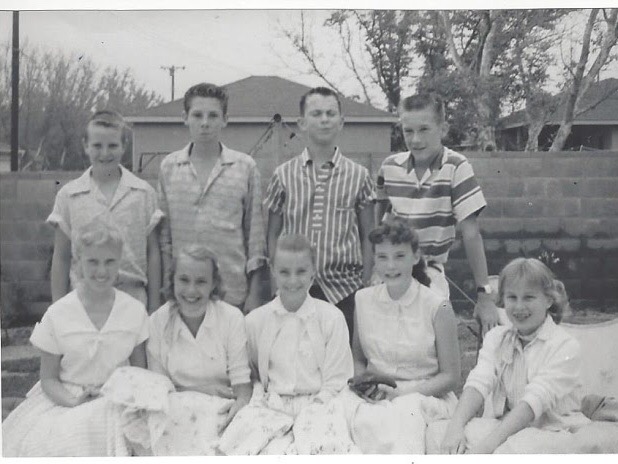From Stage 3. Early adolescence – The Thespian at the Oasis
When we moved to the valley it was still semi-rural.. My brother and I rode our bikes to catch crawdads in the LA River, which was not paved yet near our house. There were no paved sidewalks between our little tract and the elementary school we walked to. People rode horses along the dirt path we took to school. The builders must have cleared a walnut grove to make our tract because I think every little lot had a walnut tree in the front yard and the back yard. We were a new island of suburban America In a recedingly rural area. We walked 2 blocks to our swimming lessons at Stan Laurel’s old estate, grown shaggy since the 1930s.
Winnetka Avenue Elementary School
Scan the picture of teacher, Charlotte, and I in elementary school and describe here. Also Charlotte and Jim Gesner visiting me.
John A. Sutter Junior High School
Describe the junior high picture above.
Grover Cleveland High School
When I graduated from junior high and started high school in 9th grade, a brand new beautiful Grover Cleveland High School was waiting for us to be the first to ever use it. There was a class called Leadership that I was assigned into. It consisted of about 25 students, all but a handful of whom had transferred from Reseda High, which had grown too large and was split in half to start Cleveland. There were 2 of us from Sutter Junior High, the only 2 9th graders in Leadership. Instead of the traditional and traumatic role of being thrust to the bottom of the hierarchy, the transition from junior high to high school felt immensely empowering by being a peer of all the school leaders.
#1.3 of SA1. Before college
A seed of my transition from model student to hippie musician
I always used to say that I listened to Charlie Parker and Dizzy Gillespie in the cradle. But I started to be consciously initiated into what was “hip” during early adolescence. Here’s how I put it in a short piece called Dad and Drums.
This was a really great collection of jazz 78’s — Duke Ellington, Count Basie, Jimmy Lunceford big band records, and a lot of Charlie Parker and Dizzy Gillespie be-bop 78’s he bought as they were coming out in the late 1940’s and very early 1950’s. He was very knowledgeable about jazz, which was a sort of elite, kind of early hip thing (he always referred to people that didn’t know about the wonders of the jazz world as “laymen”). I could see he took great pleasure in transmitting this esoteric knowledge to his receptive and appreciative first son.
I recently read about the hipness of jazz as an early core driver of the cultural upheaval of the 1960s. Mat Callahan says in his book The Explosion of Deferred Dreams
Hip was a compass guiding the initiate through the snares and delusions obstructing their path, the path that was itself the destination. The traps were laid by the squares whose heavy hand held the reins of power, but whose arthritic grip could be eluded by those lithe and supple enough to slip through it. Rituals and elixirs were provided that both illuminated and reinforced the social bond between the enlightened. Music, particularly jazz, was fundamental. Improvisational, existential, difficult to master, and obedient only to the Muse, it was the sonic expression of a worldview that incorporated diverse elements from urban sophistication to unfettered expression.
